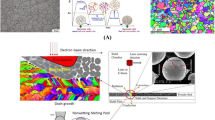Abstract
Microstructure of coatings produced by thermal spray coating process depends on many parameters, including particle impact conditions, powder materials, and substrate conditions. Because of the large number of parameters affecting microstructure, developing a computational tool that can predict the microstructure of thermal spray coatings as a function of these parameters can be of great interest as it will save time and resources when developing new coatings. In this article, we examine the validity and the accuracy of such a computational tool. We present the result of a three-dimensional model of coating formation. The model is based on the Monte Carlo method with particle impact conditions, materials properties of powder, and substrate as input. The output of the model includes coating porosity, surface roughness, and coating thickness. In order to validate the model, coatings under specific conditions were deposited and the predicted results were compared to the actual deposits. The impact conditions for these cases were measured by DPV-2000 and the raw data were used as input to the computer program. The comparison between the actual deposits and the simulated ones shows good agreement. The results demonstrate the viability and usefulness of this modeling tool in developing new coatings and understanding their microstructure.










Similar content being viewed by others
Notes
The particle conditions at specific locations on the scanning grid are measured by DPV2000. During these measurements, the position of the torch is fixed during plasma coating operation; however, plasma torch is moving and is not stationary. Therefore, at each time step, the measured particles’ positions by DPV2000 are adjusted to correspond to the new position of the plasma gun and the center of the scanning grid.
References
R. Ghafouri-Azar, J. Mostaghimi, S. Chandra, and M. Charmchi, A Stochastic Model to Simulate the Formation of Thermal Spray Coating, J. Thermal Spray Technol., 2003, 12(1), p 53-69
R. Ghafouri-Azar, J. Mostaghimi, and S. Chandra, Modeling Development of Residual Stresses in Thermal Spray Coatings, Comput. Mater. Sci., 2006, 35, p 13-26
R. Ghafouri-Azar, S. Shakeri, S. Chandra, and J. Mostaghimi, Numerical Simulation of Offset Deposition for Sequential Tin Droplet, Proceeding of International Thermal Spray Conference and Exposition, March 4-6, 2002 (Germany), 2002, p 951-959
M. Xue, S. Chandra, and J. Mostaghimi, Investigation of Splat Curling Up in Thermal Spray Coatings, J. Thermal Spray Technol., 2006, 15(4), p 531-536
M. Xue, S. Chandra, J. Mostaghimi, and C. Moreau, A Stochastic Coating Model to Predict the Microstructure of Plasma Sprayed Zirconia Coatings, Modell. Simul. Mater. Sci. Eng., 2008, 16(6), p 19
Y. Kawai and Y. Shiraishi, Handbook of Physico-Chemical Properties at High temperatures, Iron and Steel Institute of Japan, 1988, p xxi
K. Shinoda, Y. Kojima, and T. Yoshida, In Situ Measurement System for Deformation and Solidification Phenomena of Yttria-Stabilized Zirconia Droplets Impinging on Quartz Glass Substrate Under Plasma Spraying Conditions, J. Thermal Spray Technol., 2005, 14(4), p 511-517
G. Mauer, R. Vaßen, and D. Stövre, Atmospheric Plasma Spraying of Yttria-Stabilized Zirconia Coating with Specific Porosity, Surf. Coat. Technol., 2009, 204, p 172-179
H. Chen, S.W. Lee, H. Du, C.X. Ding, and C.H. Choi, Influence of Feedstock and Spraying Parameters on the Depositing Efficiency and Microhardness of Plasma-Sprayed Zirconia Coating, Mater. Lett., 2004, 58, p 1241-1245
OOF: Finite Element Modeling for Materials Science, NIST, http://www.nist.gov/msel/ctcms/oof/
J. Mostaghimi, S. Chandra, R. Ghafouri-Azar, and A. Dolatabadi, Modeling Thermal Spray Coating Processes: A Powerful Tool in Design and Optimization, Surf. Coat. Technol., 2003, 163-164, p 1-11
Author information
Authors and Affiliations
Corresponding author
Rights and permissions
About this article
Cite this article
Parizi, H.B., Mostaghimi, J., Pershin, L. et al. Analysis of the Microstructure of Thermal Spray Coatings: A Modeling Approach. J Therm Spray Tech 19, 736–744 (2010). https://doi.org/10.1007/s11666-010-9494-z
Received:
Revised:
Published:
Issue Date:
DOI: https://doi.org/10.1007/s11666-010-9494-z




